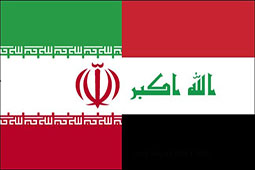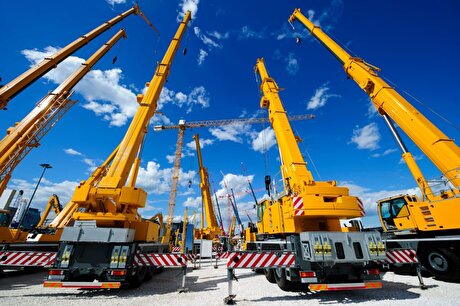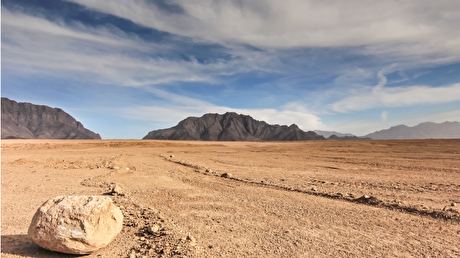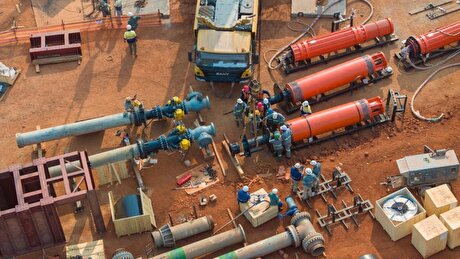
Iran Drills 7 New Oil Wells Shared with Iraq


The National Iranian Drilling Company (NIDC) has completed the operations to drill 7 wells in Azar Oilfield in Anaran block, in the western province of lIam.
According to supervisor of the project Hossein Rahimi, the operations were carried out in line with the government's push to speed up production from the field, which is shared with its western Arab neighbor, Iraq.
The official added that each well has been drilled within an average of 470 days by domestic experts.
The field is considered as one of the most difficult reservoirs to drill due to the sequence of its low- and high-pressure layers and the large number of tubes for drilling and lining of wells.
Azar holds 2.5 billion barrels of in-place oil, but new reservoir studies on the field suggest a much higher figure of 4 billion barrels. It is one of the six joint fields with Iraq, along with Dehloran, West Paydar, Naft-Shahr, Azadegan and Yadavaran.
Earlier on Sunday, the National Iranian Oil Refining and Distribution Company (NIORDC) will open 20 projects worth $1819.82 million in the current month, to commemorate the 40th anniversary of the Islamic Revolution of 1979.
According to the Iran’s Oil Ministry, the projects include the third phase of gas condensates production unit of Persian Gulf Star Refinery, the plan to increase gasoline production capacity at Bandar Abbas Oil Refining Company and improve the product’s quality, desulfurizing diesel produced at Tabriz Oil Refining Company, supplying water to Abadan Refinery and organizing the port of the southwestern Iranian city of Bandar-e Mahshahr.
Among the other projects are the 20-inch 430-kilometer pipeline passing through central Iran (Nain, Kashan and Rey) for transferring oil byproducts, another pipeline to transfer 240,000 barrels of oil byproducts per day from Abadan, in Southwestern Iran, to the Iranian capital city of Tehran and the third distillation and liquid gas production unit of Isfahan Oil Refinery.
Once the third phase of gas condensates production unit of Persian Gulf Star Refinery becomes operational, Iran’s Euro 5 gasoline production will increase 12 million liters.
The laying of the 20-inch Nain-Kashan-Rey pipeline began in 2012. On completion, it will transfer oil byproducts from the Persian Gulf Star and Bandar Abbas refineries as well as imported oil products to central and northern Iran.
The pipeline will help raise Iran’s capacity to transfer oil byproducts and imported oil products 150,000 barrels per day and 200,000 barrels per day respectively.
The project to organize the port of Bandar-e Mahshahr is aimed at increasing the port’s export capacity to 40 million tons.
As one of the most important national projects, the implementation of the plan to increase gasoline production capacity at Bandar Abbas Oil Refining Company and improve the product’s quality began in 2007.
Upon completion, the desulfurizing project of Tabriz Oil Refining Company will help the refinery produce 30,000 barrels of Euro 4 and 5 gasoline per day. The implementation of the project began in 2014.
Iran is the top oil and gas source in the Middle East with giant reservoirs of energy, and a developed network of infrastructures to transfer the resources to the neighboring countries and the rest of the world.
Earlier on January 23, Iranian Minister of Petroleum Bijan Namdar Zangeneh said that the country has discovered a new oil reserve in the Southwestern city of Abadan, Khuzestan province, rich with very light and sweet crude.
“Yesterday at 10 o'clock in the morning, a well being drilled on Mino Island reached oil. This is the first time we discover oil in the Abadan area,” Zangeneh told reporters after a cabinet session, breaking the news.
The discovery on Minoo Island was the first ever oil find in the general area of Abadan which is home to Iran’s largest and oldest oil processing facility.
“We have a lot of hope to discover (more) oil in the Abadan area and this grade discovered at a depth of 3,770 meters has an API gravity of 40 which is very light and sweet,” he added.
Zangeneh said drilling will continue to estimate the total volume of the reservoir and the possibility of production.
Iran has also to determine whether it is an independent resource or an extension of an Iraqi oilfield currently producing on the other side of the border.
"About the extension of the waiver for Iran's oil sales to some customers by the United States, we have to wait and see," Zangeneh said.
In a related front, earlier on December 17, Head of Exploration at the National Iranian Oil Company (NIOC) Seyed Saleh Hendi said that new oil and gas reserves have been discovered in Iran since last year, adding that the recently re-imposed US sanctions have had no effects on exploration operations.
“We are working in three areas of exploration of new fields, new reservoirs, and increasing the volume of already discovered fields, and we have achieved good results in all three sectors,” Hendi said in a press conference.
"There are about 40 oil reservoirs discovered and developed in the country, which indicates that the exploration sector is doing better than production and development," he added.
"Based on our Five-Year Development Plan, we have had good achievements in exploration of oil and gas reservoirs, so that we now rank first in terms of oil and gas reserves in the world."
The NOIC official added that initial exploration of oil and gas fields continues over more than 60 percent of the country, but excavating wells are carried out only in the Persian Gulf region, southwest and northeast of the country.
Gas reservoirs are identified in the Oman Sea, he said, while adding that those resources are located at a depth of 800 meters below the surface, where excavation is very expensive.
Hendi added that the success rate for exploration operations stands above 60 percent.
The NOIC official added the newly re-imposed US sanctions against Iran oil sector have had no effects on exploration operations, and the projects are continuing as usual.
He further noted, on the contrary, the sanctions have led Iran to self-sufficiency in producing equipment for oil and gas production.
Earlier on October 20, Head of the Society of Iranian Petroleum Industries Equipment Manufacturers Reza Khayyamian said dozens of European companies have voiced willingness to cooperate with Iran in developing its oil industry despite US sanctions.
"110 small and mid-sized European companies have declared preparedness to start joint ventures with Iranian firms and start operation in Iran's oil and gas industries," Khayyamian added.
He said that Iran intends to invite the European companies to hold talks with fellow Iranian firms to start joint ventures to implement projects in the country.
Despite the re-imposition of the US sanctions against Iran, many European and Asian companies have voiced enthusiasm for cooperation with the country.
The German ADL company inked an agreement with Iran's Sepahan Oil Company (SOC) in August to cooperate in technology transfer.
CEO of Iran's SOC Mohammad Ebrahimi and CEO of Germany's ADL Michael Hyde signed the cooperation document despite the US unilateral sanctions against Iran and its withdrawal from the 2015 nuclear deal.
According to the cooperation document signed between SOC and ADL, the two sides would cooperate in technology transfer in the field of oil and gas industry lubricants.
The European embassies made lots of efforts to pave the way for signing the agreement, Ebrahimi said.
ADL will implement the project in cooperation with its Austrian and Swiss partners, he added.
In relevant remarks in the same month, an official with the National Petrochemical Company (NPC) said that a major Asian consortium was planning to invest 7 billion dollars in Iran's petrochemical industry.


Gold price edges up as market awaits Fed minutes, Powell speech

Glencore trader who led ill-fated battery recycling push to exit

Emirates Global Aluminium unit to exit Guinea after mine seized

Iron ore price dips on China blast furnace cuts, US trade restrictions

Roshel, Swebor partner to produce ballistic-grade steel in Canada

US hikes steel, aluminum tariffs on imported wind turbines, cranes, railcars

Trump weighs using $2 billion in CHIPS Act funding for critical minerals

EverMetal launches US-based critical metals recycling platform

Afghanistan says China seeks its participation in Belt and Road Initiative

Energy Fuels soars on Vulcan Elements partnership

Northern Dynasty sticks to proposal in battle to lift Pebble mine veto

Giustra-backed mining firm teams up with informal miners in Colombia

Critical Metals signs agreement to supply rare earth to US government-funded facility

China extends rare earth controls to imported material

Galan Lithium proceeds with $13M financing for Argentina project

Silver price touches $39 as market weighs rate cut outlook

First Quantum drops plan to sell stakes in Zambia copper mines

Ivanhoe advances Kamoa dewatering plan, plans forecasts

Texas factory gives Chinese copper firm an edge in tariff war

Energy Fuels soars on Vulcan Elements partnership

Northern Dynasty sticks to proposal in battle to lift Pebble mine veto

Giustra-backed mining firm teams up with informal miners in Colombia

Critical Metals signs agreement to supply rare earth to US government-funded facility

China extends rare earth controls to imported material

Galan Lithium proceeds with $13M financing for Argentina project

Silver price touches $39 as market weighs rate cut outlook

First Quantum drops plan to sell stakes in Zambia copper mines

Ivanhoe advances Kamoa dewatering plan, plans forecasts

















